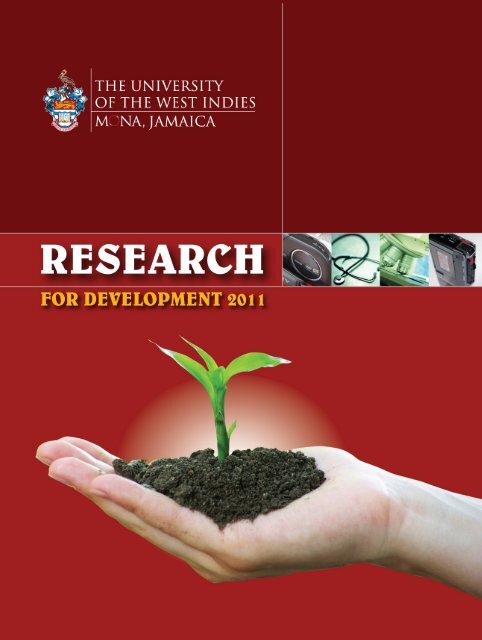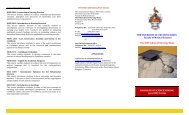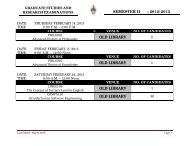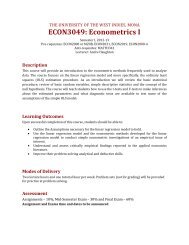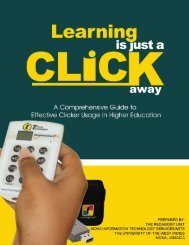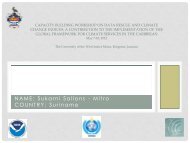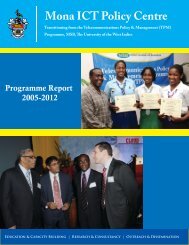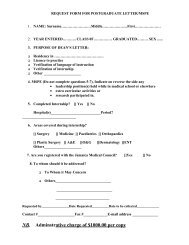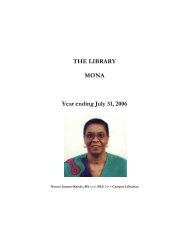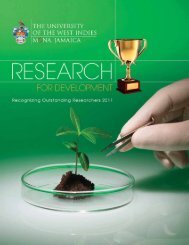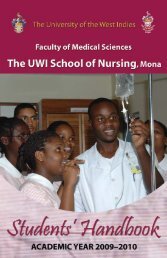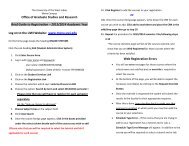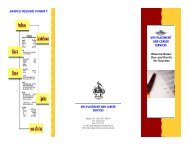Download Pdf - Uwi.edu
Download Pdf - Uwi.edu
Download Pdf - Uwi.edu
- No tags were found...
You also want an ePaper? Increase the reach of your titles
YUMPU automatically turns print PDFs into web optimized ePapers that Google loves.
Contents814182226FACULTY OFHUMANITIES AND EDUCATIONEducational Barriers, Opportunities andExperiences of Jamaican Studentswith Disabilitiesby Dr. Susan AndersonBetween two Grammarsby Dr. Beverley BryanWho Should Teach at the Lower PrimarySchool Grades?By Dr. Rose DaviesInteraction of Industrial & CommercialOrganizations with Educationby Dr. Halden MorrisResearching Jamaica’s Business Historysince Independenceby Dr. Kathleen Monteith4044FACULTY OF MEDICALSCIENCESThe Community Survey of the Elderlyby Dr. Susanne NeitaUnderstanding and InfluencingAdolescents’ World Viewby Dr. Desmalee Holder-Nevins5054586266FACULTY OF PURE ANDAPPLIED SCIENCESTapping into a Natural Resource:Under-Utilized Jamaican Fruitsby Dr. Camille Bowen-ForbesWhat is a Lionfish and Why is it Here?by Dr. Dayne BuddoJamaican Natural Products as Potential CancerMedicineby Dr. Rupika DelgodaGeological Investigations of Part of the Highway2000 Mount Rosser Bypassby Prof. Simon MitchellThe Department of Mathematics Helping theHealth Sector and Othersby the staff of the department828690FACULTY OFSOCIAL SCIENCESThe Search for Help: Experiences of AbusedJamaican Womenby Dr. Gillian MasonAn Approach for Ontology Development andAssessment Using a Quality Frameworkby Dr. Lila RaoAnalytical Study on Industry within Jamaica: InPreparation of a National Spatial Planby Dr . Kevon Rhiney , Dr. Lloyd Waller,Mr. Gavin Daley, Mrs. Shakira Maxwell,& Mr. Darron Thompson3034Understanding Teacher Professionalismin Jamaicaby Dr. Carol Hordatt Gentles, Dr. Mairette Newman,Dr. Marceline Collins-Figueroa,Mrs. Vileitha Davis-Morrison, Dr. Lorna DownMore than Statistics: Experience, Memory& Legacy in Migration Studiesby Prof. Verene Shepherd7076Is Your Cell Phone Good for You?by Prof. Mitko VoutchkovThe Potential Environmental Impact from aPower Generating Facility on a Rural JamaicanTownby Prof. Dale Webber & Mr. Carlton Campbell
PRINCIPAL’SMessageGordon ShirleyPro Vice Chancellorand Principal UWI, MonaThe UWI is proud of the work of its researchers and of the high esteem in which theinstitution is held as a result. It comes as no surprise, therefore, that the high qualityoutput of the university continues to attract extraordinary scholarship which allows us toboast the best intellectual infrastructure anywhere in the region.Research for Development 2011 creates opportunities for our researchers to collaboratewith faculty internally, regionally and internationally, in order to encourage informationexchange. As we disseminate information about our research through multiplemedia, researchers worldwide seize the opportunity to build sustainablepartnerships with us and become involved in joint innovative researchprojects. This booklet is one of the means we have chosen to share theresearch with everyone, including the ‘man in the street’. The widereadership this booklet series has enjoyed over the last few years is anindication of the interest and respect our research has generated.As each reader turns the pages of this publication s/he ought toobserve, very quickly, the breadth of intellectual endeavour evidentin the number, quality and relevance of the research being pursued.Our researchers are answering the call to engage in multidisciplinarycollaborations and partnerships with industry to ensure that ourresearch has purpose and meaning beyond the walls of the university.The UWI remains committed to sharing its expertise and guidancewith those who stand to benefit; to increasing public knowledgeand enriching the intellectual community. Our stakeholders canrest assured that the UWI will never falter in its efforts to promoterigorous research that is relevant to the region and to the widersociety.45
R E S E A R C H F O R D E V E L O P M E N T 2 0 1 1SusanAndersonEducational Barriers, Opportunities andExperiences of Jamaican Students withDisabilitiesThe sphere of disabilities and the rights of thedisabled are areas which do not readily attract theresearcher, in much the same way as the disabledas a group are often neglected in the march towardsdevelopment. It is therefore interesting that theresearch undertaken by Dr Susan Anderson addressesthe plight of this category of Jamaicans within thecontext of their potential contribution to socialand economic development; and perhaps moreimportantly, in their own right to the achievement ofpersonal excellence and a satisfying life.Lack of Equal OpportunityThe study critically examines some of the underlyingfactors that have served to put the disabled at adisadvantage. It is not surprising that this inequity hasits root in the very <strong>edu</strong>cational system which oughtreally to be the great leveller of opportunities. Atboth the primary and high school levels, the numberof persons with disabilities entering <strong>edu</strong>cationalinstitutions is greatly under-served. This has clearrepercussions for registration and admission of suchstudents at the tertiary <strong>edu</strong>cational level.Perhaps not surprisingly, negative attitudestowards persons with disabilities seem to underliemany of the problems faced by such persons.Yet, according to the researcher, those who gainaccess to tertiary <strong>edu</strong>cation, though limited innumber, clearly demonstrate that they are theequals of their non-disabled counterparts inacademic competence and are no less successful insignificantly impacting society at large. No doubta most revolutionary discovery and statementof the possibilities open to such students when<strong>edu</strong>cational barriers, opportunities and negativeexperiences are removed, allowing them access toa level playing-field!8 9
Nine Students with Disabilities ChosenThe research sample involved students withdisabilities at the secondary and tertiary levelsof the <strong>edu</strong>cational system, although the focuswas on the latter. Getting to know the particularcircumstances of the nine students in the originalsample was important. Biographical information- birthplace, when they acquired their disabilitiesand whether there were any noticeable changes inthese disabilities, parents’ occupations if still alive,[whether parents were still alive and if so theiroccupations] and their reaction to the disabilities;siblings, whether there were other family memberswith disabilities – were therefore all significant forfurther analysis.Parental responses were interesting, ranging from“shock, then denial/disbelief, anger, sadness andthen adjustment to the reality” and even a “positivestance over time”.How Does the Community React?Community responses, like those within the home,were very telling: “Well, I know... I rememberexplicitly that people within the community gaveme a lot of “stick” (teasing) because I could notwalk on the street. I remember a boy putting apiece of wire across the road for me to bump into.I saw it and stepped over it and everybody beganto laugh and say ‘How ‘im say him can’t see’ ”?No less intriguing were social experiences: “Whatreally galls me is the fact that these people wouldeven invite me to a function with no thought ofhow I was going to enter the building .. .take myexample of going to accept a university award...and my being hoisted upon the platform...howembarrassing! Mmm”... disgust.Cultural pressures and experiences born outof ignorance made the disabled feel isolated;coloured their selection of partners and influencedrelationships in different ways. “Yes, people thinkthat blindness is “catching” and they used to say“see the blin’ one deh!” “Here comes the blin’ one!”pointing or referring to him. Intimacy is veryimportant to disabled people and this might seemvery revealing to the ‘ordinary person’.Persons with disabilities love to be treatednormally. “One thing I hate about people is the waythey treat us...They even think I must smile all thetime and accept their ..ahm.. forced help, you know.I can and will manage my own affairs”.Disabled are Their Own AdvocatesIt is sometimes their own agitation and advocacywhich get matters affecting them addressed,not the support of the non-disabled: “All this talk aboutawareness and such things, yet, you don’t hear peopledemonstrating about the open manholes and trenchesthat we face on a daily basis.”With respect to academic/<strong>edu</strong>cational needs, theresearcher, Dr Anderson, found that the need foracademic achievement was as compelling for disabledindividuals as for the non-disabled: ”I feel the sameneed for achievement (as non-disabled), based on theexpectations of others (teachers and siblings). They werehappy when I was accepted to go to high school...I feltgood to be attending high school although I knew I wouldface challenges.” It was therefore not surprising thatsome “felt the need to try harder. You see, I knew it wasonly a matter of time before I would lose it even though Itried hard to hide my ...ahm blindness.”At the high school level, inclusion/mainstreamingserved to make each individual more aware ofothers with differences and encouraged workingtogether - though restricted to academic interaction.At the university level, the attitudes of both staff andstudents were more positive on the whole, though notwithout instances of insensitivity. The experiencesof students with disabilities were cases in pointto the extent that certain Orientation practiceswere banned, following the negative impact onone particular individual. Dr Anderson’s researchalso showed that social interaction tended to berestricted to academic involvement although therewas obvious respect shown for the achievement ofdisabled students: “It was only when they (studentsand teachers) saw that I could manage my work(academic) that they started to show me respect...I was encouraged by their behaviour to work evenharder”.Support Services InadequateWith respect to the physical dimension, Dr Andersonfocused on special support services, which weresadly lacking in developing countries such asJamaica, thus placing students with disabilities at atremendous disadvantage. This was so even in thematter of counselling: “I was really amazed that thecounselling service was not equipped to handle mycase,” said a student who claimed he was mentally10 11
R E S E A R C H F O R D E V E L O P M E N T 2 0 1 1BeverleyBryanBetween twoGrammarsTeaching Jamaican Creole speakers, with a goal ofcompetence in English, means teaching between twogrammars. This is so because learners and teachersoperate in a space where two languages, English andJamaican Creole, co-exist and sometimes overlap asboundaries are blurred.14 15The Problem Exists Far and WideDr Beverley Bryan had a concern about the challengesfacing teachers of English in Jamaican classrooms andset about to identify some of the core problems. Asa Language Educator, she has encountered JamaicanCreole speakers, initially from her experience ofteaching adolescents and adults in the UK, andmore recently from teaching and conductingresearch in Jamaican schools. Essentially, these arestudents who have struggled with demonstratinglanguage proficiency at the level that would meetthe requirements of high-stake public examinations.Their failure has underscored real inequity in an<strong>edu</strong>cation system that demanded so much but did notprovide the resources for success. What was alwaysan issue for her was that this failure was often miredin a debate about language and identity that gaveBurgess’ statement “Language is an arena rather thana subject” such resonance.Understanding the ProblemThrough her own practice, she began to develop aninterest in understanding the language background ofJamaican Creole speakers: the nature of the languagethey used; the context of its use and application inclassrooms.
The questions remained constant: what kind of languagedo the participants in these classrooms speak? Where dothese ideas and perceptions of the language come from?What is the historical background to the choices made aboutlanguage teaching? What is the socio-cultural context thatthe teacher needs to understand, to connect the society’slanguage goals with the individual’s needs? How does theteacher promote competence in the target language whilemaintaining confidence in the mother tongue? What doesgood practice in this context look like?Dr Bryan sought the answers to these questions inconducting her own research and reviewing that ofCaribbean and international practitioners. The researchwas conducted over a number of years in several differentprojects, focused on secondary schools. It draws onhistorical sources, observations, interviews and surveys.However, Dr Bryan has taken into account the ideas andpractices of classroom teachers, because in this way theprofessional knowledge and expertise that underpins goodclassroom practice is recognised.Publishing the ResearchDr Bryan wanted to share her findings with English teacherswho were confronted with the challenges presentedby the Jamaican Creole/English speaking students. Shedocumented all her findings in a book entitled BetweenTwo Grammars: Research and Practice for LanguageLearning and Teaching in a Creole-speaking Environment.It is towards enriching the practice of these teachers ofEnglish in secondary schools that a substantial part of thisbook is addressed. The first aim is to present an enrichedview of the multiple meanings of language and Englishin teaching in the Caribbean, considering the differentways language is viewed - in particular the language thatsecondary students are acquiring. It is understood thatteachers need to be provided with the tools to navigatethe arena, so that they can interrogate their responses tolanguage.achievement in literature. What is more important, or as important, in this Creolespeakingenvironment, is TLA. Dr Bryan’s research suggested that some intuitiveunderstandings were already there. After all, most teachers have been involved in thelinguistic struggles their students face. But the objective is to make that knowledgeexplicit to the teacher and enrol her in the project of language teaching.No Single SolutionDifferent approaches are reviewed in this book, based on the research carried outin classrooms. The approaches cover teaching language as communication; the useof literature in the language classroom; and the central value of language study. Theimplementation of these approaches is analysed in relation to the principles outlined,so that teachers can make theoretically sound pedagogical decisions about what theyoffer students. Finally, what is offered to the teacher are ways of working that she,as empowered professional, can take and own. Ultimately, the goal is to empowerteachers to develop a critical reflective perspective on their practice that allows themto see such practice in a wider system of meaning-making.Thus, while the difficulties of language teaching are recognised, it is also appreciatedthat the findings, discussions and solutions suggested are multi-faceted.Beverley Bryan is the head ofthe Department ofEducational Studiesbeverley.bryan@uwimona.<strong>edu</strong>.jmSo once the findings are examined, the aim in the second halfof the book is to go beyond the presentation of one singlemethod for achieving proficiency in English. Apart fromknowledge of subject, teachers need an understanding ofthe principles of knowledge and learning that would allowthem to make theoretically sound and rigorous pedagogicaldecisions about what they offer to students. Principlesare strands of curriculum thinking, drawn from secondlanguageresearch and practice that are robust enough togenerate teacher action at more than one level: they spiralthrough the curriculum and offer guidelines to the teacherin approaching her practice.To apply the principles, teacher preparation must deepenteacher expertise; development of teacher languageawareness (TLA) is required for language and literacyteachers of English. Many teachers come with a facilitywith language generally expressed in a love for and16 17
R E S E A R C H F O R D E V E L O P M E N T 2 0 1 1RoseDavies“Based on how I see these early childhoodteachers teach and the methods they use,the children must learn.”Who Should Teachat the Lower PrimarySchool GradesThis was the view expressed by the principal of aninner city Primary and Junior High School in Kingston,Jamaica, during an interview with Dr Rose Davies,Senior Lecturer and Head of the Institute of Education,UWI, Mona. Dr Davies was collecting data for a casestudy research on the principal’s teacher deploymentinitiative aimed at improving the standard of teachingand learning in grade one.The principal had embarked on an initiative toplace teachers trained as early childhood <strong>edu</strong>cationspecialists in all his grade 1 classrooms. Why? Heexplained that in his first years as principal hebecame increasingly concerned about the lowperformance levels of children coming into grade 1from the community and their failure to demonstratesatisfactory progress by the end of grade 1. This wasparticularly acute in the area of literacy developmentand he was seeking for some way to improvethis situation. He acted on an ideathat came to him after observing anew teacher he had employed fora special grade 1 class of slowlearners.18 19
R E S E A R C H F O R D E V E L O P M E N T 2 0 1 1HaldenMorrisInteraction of Industrial& CommercialOrganizationswith EducationA primary objective of all <strong>edu</strong>cational programmesis to prepare persons to be engaged in various aspectsof the society. A significant portion of these persons arefor the workforce. A major concern of technical andvocational <strong>edu</strong>cators is the perceived lack of involvementof industrial organizations in the planning, developmentand implementation of the curriculum at various levelsof the <strong>edu</strong>cational system. The result is a failure ofthe <strong>edu</strong>cational institutions to meet the expectationsof industries. Since 2006 Dr Halden Morris, seniorlecturer in the Institute of Education, UWI, Mona hasbeen conducting research to determine the extent towhich industries interact with <strong>edu</strong>cational institutions inJamaica and the benefits of the interaction.The ProblemA perceived lack of involvement and interaction ofcommercial and Industrial organizations in curriculumdevelopment and implementation at the secondaryand post secondary levels in Jamaica.Getting to the Root of the ProblemData were collected from a wide variety of<strong>edu</strong>cational institutions on their interaction withindustry. Twenty-two institutions grouped infive categories were included: technical highschools (7), secondary schools (8), HEART/NTA training institutions (4), traditionalhigh schools (2), and one tertiary levelinstitution. The industries and commercialentities targeted were bauxite and miningfirms, consumer goods manufacturing,automobile and service industries/corporations.22 23
Industries’ Commitment to EducationData from this investigation revealed thatindustrial organizations contribute resourcesto <strong>edu</strong>cational institutions not just for thesake of philanthropy but also to satisfytheir commitment to <strong>edu</strong>cation, which is anunderpinning philosophy of the industry. Theindustrial/commercial organizations stronglybelieved that they have an important role toplay in preparing students for employmentin industry. They confirmed the belief thatthey should be involved in the curriculumimplementation process, especially in the areaswhere they may have direct benefits.Factors which Influence Industries toContribute to Educational InstitutionsIn addition to philosophy, there are specifickey factors that influence each industrialorganization in contributing to <strong>edu</strong>cationalinstitutions. Factors indicated by industriessurveyed included the leadership of theinstitution, proximity to the industry, highvisibility of school in sports, crime level,government policy, establishment of standardsand the need to prepare a smart competentworkforce.Concern about Existing CurriculumSome industry personnel were particularlyconcerned about the current content andstructure of the curriculum because many ofthe values, attitudes, skills and competenciesrequired by industry were not evident. Severalindicated that the curricula in the <strong>edu</strong>cationalinstitutions are in many instances outdatedand are not engaging the students in modernpractices. This manifests itself in the lack ofappropriate persons available in the communityfrom which the industries could benefit.Work Experience Opportunities InadequateAll <strong>edu</strong>cational institutions involved in thesurvey employed a work experience programmeas part of their curriculum. However, theexperience was not tied to any specific trainingneeds of the student but merely focused on thestudent making a connection with the worldof work. While expressing appreciation forthe opportunities provided by the industrialorganizations, they claimed that in manyinstances, the opportunities provided werenot directly related to the training needs of thestudents.Types of Contributions Made by Industries to EducationalInstitutionsAll industrial organizations surveyed focused primarily on providingmaterial assistance to the <strong>edu</strong>cational organizations. Fifty-five percent(55%) of the industries surveyed provided direct financial assistance forthe <strong>edu</strong>cational institutions with which they interact. Fifty percent (50%)provided opportunities for work experience of students. Approximately60% of the industries provided scholarships for either excellent orneedy students. A similar percentage provided books, materials, toolsand equipment for the <strong>edu</strong>cational institution. Not surprisingly, a largepercentage (68%) provided job opportunities for the students from theinstitutions with which they interact. Approximately eighteen percent(18.20%) provided assistance of a general nature which includedcurriculum development.Management of Interaction between Industries and EducationalInstitutionsBoth <strong>edu</strong>cational and industrial respondents indicated that therewas need for improvement in the management of their interaction tofacilitate industries’ involvement in the curriculum development andimplementation. All respondents in the study indicated that the principalor the chief executive officer of the <strong>edu</strong>cational institution should begiven the responsibility to administer and coordinate the interaction, butthat personnel from both organizations should participate in managingthat interaction.Future PlansAll <strong>edu</strong>cational institutions and industries surveyed supported theconcept of industries interacting with <strong>edu</strong>cational institutions. While notmaking specific commitments, more than seventy-five percent (75.50%)of persons from industrial organizations interviewed pledged to givecontinuous support to these programs, however, most were concernedabout its sustainability because this interaction requires continuoussourcing of funds to maintain the programmes. Two industries were lessconcerned about sustainability since they had established Foundationsthrough which these engagements are managed.Economic BenefitsThe economic benefit of the formal interaction between the industrialorganization and <strong>edu</strong>cational institutions is no doubt important andcan be a significant engagement. One major benefit is the level ofconfidence that both industry and the <strong>edu</strong>cational institution will havein their programmes. Another benefit is the r<strong>edu</strong>ction of frustrationof determining curriculum content, especially in the determination ofcontent which is truly relevant for both instructional and occupationalsettings. Industries expressed that a major benefit is the r<strong>edu</strong>ction ofthe training that they have to provide for the graduate when employed.The student will graduate with a good understanding of the demandsof industry. Lack of interaction may result in pressures from business,industries, professional organizations, unions and other entities that relyon the curriculum for their development.Halden Morris is a senior lecturer in the Institute of Education.halden.morris@uwimona.<strong>edu</strong>.jm24 25
R E S E A R C H F O R D E V E L O P M E N T 2 0 1 1KathleenMonteithResearching Jamaica’s Business Historysince IndependenceA rich body of work concerning the historyof Jamaica’s business activity and businessdevelopment exist, primarily through thepioneering efforts of historians such as DouglasHall, and Richard Sheridan. Their work, and thatby others who followed them, is understandablylargely confined to the agricultural sector,usually to the large-scale production units of theplantation, or to the small-scale peasant farming,both in terms of capital and labour and the relatedsectors of trade and commerce. Much of thiswork, again understandably, is on 18th and 19thcentury Jamaica, but there are a few works thathave begun to include the early to mid 20thcentury.Much remains to be researched in the 19th to the mid 20thcentury, but there are sufficient grounds to begin to shift thefocus to include the second half of the 20th century. First,the Jamaican economy has undergone tremendous changesbeginning in the mid 20th century, when the Puerto Ricanmodel of development was adopted, resulting in expansionand significant diversification. Since the 1950s and beyond,Jamaica has seen rapid expansion and development in businessactivity in the area of tourism and hotel sector,mining, manufacturing, construction, tradeand commerce, and other related servicesector industries such as in finance,retail and wholesale establishments.26 27
That we are about to enter the 10thyear of the 21st century, providesadded grounds for fast-tracking tobegin documenting the history ofbusiness activity in the 20thcentury.The second and perhapsmore important rationale forthis project, is that many of theprincipal players who were at thehelm of businesses that began in the mid20th century, and which went on to becamesubstantial entities throughout the course of thecentury, are now in their senior years.Oral TestimoniesAn important aspect of the research project isrecording the personal experiences, views andopinions of business persons who were integralto the companies they established and led forposterity. The memories of their experiences,views and opinions are vital primary sources fora proper understanding of the course of businessdevelopment in 20th century Jamaica.Business persons in the following areas of industryhave been identified for interviewing:-• Agriculture/Dairy• Banking and Insurance• Construction & Real Estate development• Commerce – Wholesale and Retail establishments• Manufacturing• Mining• Publishing (newspapers, magazines, books)• Advertising• Restaurant and Fast Food• Shipping and customs brokerages• Travel & TourismThis Study is ImportantThis study will become a valuable source of thehistory of individual businesses and will helpfurther the advancement of the business historyand business development studies programmesat the University of the West Indies, Monacampus. It will also provide models of enterprisefor researchers and industry practitioners andprovide the foundation for the establishment of anArchives of Business at the University of the WestIndies, Mona campus.Kathleen Monteith is head of theDepartment of History and Archaeologykathleen.monteith@uwimona.<strong>edu</strong>.jm28 29
Carol HordattGentlesMairetteNewmanMarcelineCollins-FigueroaVileithaDavis-MorrisonLornaDownR E S E A R C H F O R D E V E L O P M E N T 2 0 1 1Understanding Teacher Professionalismin JamaicaI n the current context of <strong>edu</strong>cational transformation,policies tend to focus on accountability, quality assurance,and improved <strong>edu</strong>cational quality. Internationalresearch suggests that there is a strong link betweenquality in <strong>edu</strong>cation and how teachers view and conductthemselves as professionals. The professionalization ofteachers’ work is therefore a key concern.Towards a Shared Vision of Teacher ProfessionalismUnfortunately, in Jamaica and the wider Caribbean, howteachers think about their work as professionals and theeffect of this on their actual teaching is not a subject thathas been well-researched. In other words, we do notknow how our teachers conceptualize professionalism.We do not know what principles and norms are guidingtheir practice. We do not know what motivates theircommitment to the teaching profession or what factorsinfluence this commitment. It seems therefore thatthere is an urgent need to find out from teachers whattheir thinking is in regard to their practice, their level ofcommitment and standards for teaching. This type ofinformation is needed to improve our understanding ofteacher professionalism and can be very helpful for givingteachers a voice in the process of developing standardsfor teaching and the work of teachers.30 31
In keeping with its remit to facilitate professionaldevelopment of teacher <strong>edu</strong>cators, a team ofresearchers from the Institute of Education set outto1. Explore how prospective, beginning andexperienced teachers in Jamaica understandthe concept ‘teacher professionalism’2. Identify the norms and ideals they associatewith professional behaviour3. Examine the sources of their views4. Examine how and why their conceptualizationsdevelop and change over timeLed by Professor Hyacinth Evans (now retired), theteam designed a three-stage, five-year longitudinalstudy. The study aimed to provide new knowledgeabout how prospective, beginning and experiencedteachers in Jamaica develop and modify theirconcepts of professionalism and professionalpractice over time.How Prospective Teachers Understand TeacherProfessionalismThe research team used concept maps and semistructuredinterviews to explore how 52 prospectiveteachers from three teachers’ colleges in Jamaicathink about professionalism and how their collegeexperiences influence their understandings.Findings from Stage 1 have been organizedaround four themes related to understandings ofprofessionalism. Most predominantly, prospectiveteachers described the professional teacher as agood person. They defined ‘goodness’ as a set ofpersonal attributes - trustworthiness, honesty,modesty, and helpfulness, among others. Added tothese were professional attributes – a set of ideasof what a good teacher should be – confidential,accountable, committed and respectful. Theseprospective teachers also saw the professionalteacher as someone who understands thecomplexity and demands of teaching. As part ofthis understanding of complexity, the professionalteacher was seen as someone who can manage thetensions and challenges associated with teachingand being a teacher. Finally, several prospectiveteachers explained how their college experiencehad played a central role in influencing theirconcepts of what it is to be a professional teacher.How New Teachers Experience their First YearStage 2 of the study is currently underway; itfocuses on the experiences and challenges of thosein their first year of teaching.Preliminary findings suggest that although somebeginning teachers have positive induction experiences,many do not benefit from the type of professionallearning and support that they need to help themdevelop good teaching habits and practices. Theresearch team found that these new teachers face avariety of challenges – instructional, management,institutional and psychological - that can make orbreak their ability to become good teachers and makemeaningful contributions to their schools and theteaching profession.Next StepsThe team will conduct follow-up interviews withparticipants for up to five years after graduation toexplore how their understandings of professionalismare changing and developing over time. The qualitativedata from these first two stages will inform the design ofthe third stage – a cross-sectional survey of experiencedteachers. This research project is expected to benefit<strong>edu</strong>cators, policymakers and the wider communityby providing knowledge about what it means to be ateacher in Jamaica, the development of professionalismamong beginning teachers, and factors that influencethis development and teacher commitment to theprofession.Carol Hordatt Gentles is a lecturer in Education withthe Institute of Education.carolgentles1@yahoo.comLorna Down is a senior lecturer in the Institute ofEducation.lornadown@yahoo.comMarceline Collins-Figueroa is a lecturer in science andenvironmental <strong>edu</strong>cation in the Institute of Education.mcolfig@yahoo.comMairette Newman is a lecturer with the Institute ofEducationmairette.newman@uwimona.<strong>edu</strong>.jmVileitha Davis-Morrison is a lecturer in Social Studies/Citizenship and Geography Education in the Institute ofEducation.vildm@yahoo.com32 33
R E S E A R C H F O R D E V E L O P M E N T 2 0 1 1VereneShepherdMore than Statistics: Experience, Memory& Legacy in Migration StudiesWe all know that Caribbean populationsare multi-ethnic and multi-cultural. That is, theyare made up of people from different ethnic groupsand cultural origins. That diversity has given riseto national mottos such as Jamaica’s “Out of Many,One People.” But how did the Caribbean become sodiverse in its population make-up? The answer liesin migration studies. Indeed, the study of populationmovements into and out of the Caribbean has engagedthe attention of scholars for some time now and is thescholarly pre-occupation of several at the Universityof the West Indies. Migration studies form an essentialaspect of the field called “Atlantic Studies.” In fact,immigrants made the Atlantic World function, makingplaces like England, Scotland and France rich.34 35
The population movement that has attractedmost attention is the transatlantic trade in Africancaptives. It is now well-known that well over 15million Africans were forcefully transported to theAmericas. But white immigration from Europewas also a vital feature of the Caribbean colonialsystem, which required settlers, managers,artisans and a governing elite. Immediatelybefore and after slavery was abolished, Caribbeanlandholders sought additional labourers fromAfrica, Asia, Europe and North America. After1930, the voluntary migration to and settlement inthe Caribbean of entrepreneurs and professionalsfrom many parts of the world, a large percentageAsian (Chinese and Indian) and Middle Eastern,further cemented our role as a recipient of diversepopulations.But migration is not only confined to the historicalpast. The current pre-occupation with the spateof refugee migration, in particular the migration ofCubans and Haitians to the USA and the Caribbean,the continuing global debates over trans-nationalidentities, human trafficking, new and stringentimmigration rules and the relationship of socalledresident and non-resident aliens to bordersecurity, are all indications that migration does notonly lie at the centre of modernity, but continues tocharacterize the post-modern age.In this post-modern age, however, scholars aremore interested in the human face of migrationrather than in counting people. In fact, for toolong, the study of slavery was dominated by thenumbers game, the futile attempt to count howmany black people were involved in the mafiaor African holocaust. Even the most recentdatabase on the transatlantic trade in Africancaptives is all about numbers: of ships, of voyages;of people; of mortality rate etc. Post-slaverymigration studies were equally preoccupied withquantitative analysis: how many were imported;how many repatriated; how many acreages didthey make productive? What was the male/female ratio? How many re-migrated? How manymerchants and doctors arrived? What percentageof the population are Indians, Chinese, Lebanese,Portuguese, Jews, indigenous peoples? And onand on – counting, counting.Of course statistics are important. They providean idea of the magnitude of population loss or gain,of gender disparities, of changes in residentialpatterns etc. But the history of migration is morethan statistics; and happily the field has changedtake on board social experiences, memories of migration(using oral history to learn about migrants’ experiencesin their own voice); and the socio-economic and politicallegacies of migration – forced and free - especially theissue of “ranking” (scholars urging host societies to treatcultural differences in an egalitarian manner, rather thanhierarchically).Gender and migration is a growing research field, scholarsasking the question: did men and women, boys and girls,experience migration in the same way or differently? Theforthcoming publication Engendering Caribbean History:Cross-Cultural Perspectives, being edited by VereneShepherd, will shed some light on this matter, a wholesection being devoted to “Gender, Migration & Identity.”Verene Shepherd is Professor of Social History,University Director of the Institute for Gender &Development Studies and Host of “Talking History” onNationwide 90 FM.verene.shepherd@uwimona.<strong>edu</strong>.jm36 37
F A C U L T Y O FMEDICALSCIENCESDr. Susanne NeitaDr. Desmalee Holder-Nevins
R E S E A R C H F O R D E V E L O P M E N T 2 0 1 1SusanneNeitaThe CommunitySurvey of the ElderlyUWI, acknowledging the growing importance ofan ageing population, awarded a New Initiative Grantto the Department of Community Health and Psychiatry(Mona Ageing and Wellness Centre), which - underthe leadership of Professor Denise Eldemire-Shearer- conducted a survey of older persons living in the StAndrew communities of August Town and Mona Heights.The study, which was done over six months in 2010,obtained a wealth of data on the mental and physicalhealth of older people, and on their social and economicsituations. The initial report from the study focused ondementia and determined the proportion of persons withthis condition and factors associated with it.Dementia is a brain disorder that causes problems inmemory, thinking and overall functioning, which worsenwith time. It mainly affects elderly people and occurs atincreasingly higher rates as ages increase, though notevery older person develops the condition. It is a highlydisabling disease which causes dependency and lossof productivity in affected persons. Frequently familymembers who have to care for them suffer financialand emotional strain, and lose productivity themselvesas needs for caregiving mount. Additionally, dementiais costly to the public health sector and the nationaleconomy as a whole, due to the expense of treatments,the high levels of care that are necessary, as well as theaforementioned losses in productivity.When results of the study were related to the Jamaicanpopulation we found that approximately one in twentypeople aged 60 years and over has dementia.40 41
Compared with studies of dementia in othercountries, our results showed that the Jamaicancommunity sample would rank fairly low inthe global proportion of elderly with dementia.Reasons for Jamaica’s low prevalence can befound in certain health-related trends. Theprimary trend is the rapid growth in size of theelderly population due to persons living longer;greater numbers of older people means morepeople at risk for the disease. A second trendis the rising numbers of people with chronicillnesses such as hypertension and diabetes;these diseases increase the risk of affectedpeople developing dementia. A third trend is theincreasing number of people with obesity, owingto people changing their diet to that more typicalof industrialized countries; obesity predisposesaffected persons to many chronic illnesses. Thesetrends - changes in patterns of ageing, chronicdiseases and nutrition - are at early stages inJamaica, so dementia rates are currently low, butas the trends progress, rates will rise to thoseseen in industrialized countries.There are further implications: if retirementpatterns remain the same, with the growingproportion of elderly people there will be asmaller proportion of persons in the workforceto meet the increased demand for health servicesdue to dementia; hence a serious nationaleconomic strain can be expected.Given the projected future rise in numbers ofpeople with dementia and the major economicburden associated with the disease, research ondementia in Jamaica is vital at this time. UWI willbe expected to continue providing the necessaryleadership. Information from this and futurelocal studies can be used in a timely manner toplan interventions which will r<strong>edu</strong>ce the impactof dementia on society.Specifically, data from this study could be usedas the basis for decision-making and budgetallocations regarding the needed governmentsubsidy of medications used in the treatmentof dementia. Our data can inform the allocationof personnel and financial resources for thetraining and employment of health care workers,the development of nursing care facilities, andthe development of social services for patientsand caregivers. Information from this study canalso aid social planning regarding workforcelevels, retirement and pensions.When results of the study were related to the Jamaicanpopulation we found that approximately one in twenty peopleaged 60 years and over has dementia.Other results from the study can be used to prioritizetreatment and preventative care for the chronicdiseases and lifestyle factors which increase dementiarisk in the Jamaican population. Our results alsosuggest the need for research beyond the scope ofdementia studies into these risk factors, researchthat could be undertaken by our colleagues in othermedical disciplines.It is hoped that our research will help improve the livesof older persons and their families and aid nationaldevelopment. More reports from this study will bepublished in the near future.Susanne Neita conducted this study as her thesis forthe degree of Doctor of Medicine in Psychiatry at theUniversity of the West Indies.sneita10@hotmail.com42 43
R E S E A R C H F O R D E V E L O P M E N T 2 0 1 1DesmaleeHolder-NevinsUnderstanding and InfluencingAdolescents’ World ViewWhy Adolescents?In the Caribbean, adolescents (youths 10-19 years)comprise a quarter of the population, while in Jamaicathey account for one-fifth of the national figures(according to the World Health Organization andthe Statistical Institute of Jamaica). As adolescentsgrow they become vulnerable to health conditions,especially as they engage in risky behaviours. Despitenegative experiences, however, adolescents can beresilient; they are dependent on their peers andresponsible adults for support to bring out the bestin them. In order for us to give this support it isimportant to understand some factors that influencetheir decision-making and behaviour. In this way, wecan be more equipped to use a preventative approachin preserving and protecting the health of adolescents.44 45
Music as a Social Influence on TheirHealthThere is no doubt that music is animportant part of adolescents’ lifeand changing this is not an option.Understanding the music of adolescentsand the role this medium may playin shaping values about sexual andreproductive health (SRH) is importantand worth investigating. In view of themany concerns in Jamaica about thecontent of dancehall music, this matterdemands not only an understandingof how adolescents perceive sexualityrelated messages conveyed throughdancehall but also whether thesemessages are more valued than thosecontained in public <strong>edu</strong>cation campaignson the topic. We used a mixed researchmethod approach to understand theseissues among Jamaican adolescents, witha view to providing data that can informhow best to use the music media to reachadolescents in a positive way.How does this Information Help to Solve the Problem?Media literacy sessions and discussions on sexuality issues are importantactivities from which adolescents can benefit. Discussions with parents,health care providers, peer leaders and adolescents themselves aboutissues of sexuality and how the music media can influence decisions, arepart of our community outreach activities. Persons in the target group arebeing reached through community interventions and discussion forumsto help clarify values and develop support systems for adolescents tomake practical but safe choices in the area of sexual and reproductivehealth. A community intervention in St Ann, ‘Real Potentials of RuralYouths’, is one means through which high risk adolescents are beingreached to build media literacy skills while addressing other social andlearning needs.Desmalee Holder-Nevins is a lecturer in Health Promotion in theDepartment of Community Health & Psychiatry, Faculty of MedicalSciences.desmalee.holdernevins@uwimona.<strong>edu</strong>.comA Peep into their WorldWe spoke to adolescents considered asleaders among their peers to find outwhat were some of the songs they listento. We then found these songs, looked atthe words and listened to them and shortlistedthose having lyrics about sexualityissues for further exploration. Nextwe visited dance sessions frequentedby some adolescents to observe dancemoves and other responses to favouritesongs. The information gleaned throughthese sources was then used to developquestions used in discussion groupswith adolescents to further clarify theirperspectives on sexuality issues in themusic.The results show that Jamaicanadolescents love dancehall music andare receiving a lot of instructions aboutlife from this source. But some messagesportrayed through songs and musicvideos contain explicit and graphicexpressions of sexuality that may bemisleading. Without the support ofresponsible adults in discussing andclarifying some of these issues, they arelikely to be influenced by messages thatconflict with those advocated by familylife <strong>edu</strong>cators.46 47
F A C U L T Y O FPURE ANDAPPLIEDSCIENCESDr. Camille Bowen-ForbesDr. Dayne BuddoDr. Rupika DelgodaProf. Simon MitchellMembers of the Mathematics Dept.Prof. Mitko VoutchkovProf. Dale Webber & Mr. Carlton Campbell
R E S E A R C H F O R D E V E L O P M E N T 2 0 1 1CamilleBowen-ForbesTapping into a Natural Resource:Under-Utilized Jamaican Fruits50 51It is a well-known fact that the place we callhome, Jamaica, is rich in medicinal plants. Go to anycommunity - rural or urban - and ask someone abouta possible treatment for cold or fever, and it willbecome clear that the use, or at least the knowledge,of traditional medicines is quite prevalent. Amongthe parts of these plants that are most frequentlyused are the leaves, roots, and bark. Fruits are lessoften employed as medicines, and when they are, it isusually the unripe fruits that are used. It has alwaysbeen known that fruits are good for health. However,over the last few decades, there has been significantlyincreased interest and focus on fruits and their rolein prevention of various diseases, such as cancer,arthritis, cardiovascular disease and Alzheimer’sdisease. Jamaica is among the most fruitful countriesof the world, and many of our edible fruit species arenot known by the masses. As a result of this, theirinclusion in the diet, cultivation, and use in researchand food product development has not been exploited.Promising Results from Jamaican FruitsThe research has revealed that the Jamaican berriespossess high antioxidant activities and levels ofanthocyanins, which are comparable to those foundin similar commercial varieties sold in the USA.Anthocyanins are the compounds responsible for theorange, red, blue and purple colours of most flowers,fruits and other plant parts. They protect cells fromoxidative damage and possess anti-inflammatory,anti-cancer, anti-diabetic and other properties.The Jamaican berries demonstrated superior antiinflammatoryand anti-cancer properties whencompared to their overseas counterparts. Additionally,compounds isolated from the red raspberries showedanti-cancer activity.
It was discovered, after carrying out a comparative study on the commonand strawberry guavas, that the strawberry guavas are significantlysuperior to common guavas with respect to their vitamin C content,antioxidant activity and total polyphenolic content. Polyphenols arecompounds that are known for their high antioxidant activity. Manyof the health benefits of vegetables and fruits are attributed to thepresence of these polyphenols, which include the anthocyanins.Strawberry guavas were also found to possess only slightly lower levelsof crude fibre than their counterparts, and therefore may be classified asantioxidant dietary fibre (ADF), as is the case for common guavas. ADFcan be defined as a product containing significant amounts of naturalantioxidants associated with the fibre matrix. A diet high in fibre hasbeen associated with r<strong>edu</strong>ced constipation, haemorrhoids, coronaryheart disease, diabetes, and cancer.Potential Application of the ResearchThese studies are proof that our under-utilized edible fruits are valuablenatural resources. Positive findings like these can and should lead toproductive exploitation of this resource. Cultivation of the fruits andfurther conversion to value-added food products such as jams, jellies,purees, juices and tarts would have a positive effect on our food andagricultural industries. Consumption of these as well as the fresh fruitswould have a positive health impact. Product development is an area ofinterest of the research group.Camille Bowen-Forbes is a lecturer in the Department of Chemistry witha keen research focus on the nutraceutical properties of underutilizedJamaican fruits, and their potential applications.camille.bowen02@uwimona.<strong>edu</strong>.jmKayanne McCook-Russell is a postdoctoral research fellow workingwith Dr Bowen-Forbes.kayanne.mccook@uwimona.<strong>edu</strong>.jm52 53
R E S E A R C H F O R D E V E L O P M E N T 2 0 1 1DayneBuddoWhat is a Lionfish and Why is it Here?The lionfish belongs to a group of venomous fishes and is related to thescorpionfish which is found regularly in Jamaica. It is a “sit-and-wait” predator,capable of consuming large quantities of fish and shellfish daily and cannegatively impact the fish stocks in a country. Its venomous spines protectit from itself becoming prey for other fish, and these spines are also capableof inflicting a very painful sting to humans. There have been documentedenvenomations in Jamaica.54 55
The lionfish (Pterois volitans and Pterois miles) isnative to the Indian and Pacific Oceans. In the late1980s and early ‘90s, marine aquaria enthusiastsmainly in the USA imported these flamboyantand spectacular fish for their homes and offices.However, for many reasons, these fish werereleased into the canals and seas, and “set free”.Since then, they have made their way along the eastcoast of the USA, the Bahamas, Hispaniola, Cuba,Jamaica, and many other countries throughout theCaribbean.Already they have been showing signs of impacton juvenile fish and shellfish, and many countriesnow are reporting staggering numbers of lionfishon their reefs and other marine environments.The lionfish reproduces all-year round in theCaribbean (every 4 days). A female lionfish iscapable of producing 2 million eggs each year.Lionfish in Jamaica have been found in very shallowsea-grass areas as well as in areas 335m (1100ft)deep below the surface. They have been recordedin Jamaica to lengths of 51cm (20 inches).The lionfish has been described as highly invasivein the Caribbean, due to its negative impacts on thereef ecology, economy and public health.The National Lionfish ProjectThe National Lionfish Management Project inJamaica is being led by the University of the WestIndies (UWI) through the recently formed MarineInvasive Species Lab at the Discovery Bay MarineLab (DBML) in St. Ann. This project is fundedmainly by the Global Environment Facility, theGovernment of Jamaica and the University of theWest Indies, for a total project budget of 431,000USD.Dr. Dayne Buddo is the Principal Investigator, withsupport from Dr Karl Aiken and other members ofthe Centre for Marine Sciences, UWI. The projectis administered by the National Environment andPlanning Agency (NEPA) and forms part of a largerregional project on invasive species in general,involving 5 countries.The project aims to track the invasion throughunderwater surveys island-wide, document theimpacts through predation of native fish, design atrap capable of catching lionfish and formulate amanagement plan for Jamaica and the rest of theCaribbean region.Research Programme on Lionfish in JamaicaMarine Invasive Species Lab – UWI DiscoveryBay Marine LabThe Research Programme on the Lionfish is the primaryfocus of the Marine Invasive Species Lab, along with ballastwater management. Under the Lionfish Programme, thefollowing elements of research are being done:• Underwater surveys of reefs island-widefor lionfish - by personnel from the UWI-DBM andother agencies island-wide• Examination of stomachcontents for the fish that are beingconsumed by the lionfish• Design of special trapsfor lionfish – these mustbe put out to sea to catchthe predators• Analyses of thegenes of the lionfish todeterminethe origin andfeatures of thespecies, to assistwithmanagementin theCaribbeanExaminationof the featuresof the lionfishlarvae, its spread, and thefood being consumed by thelarvae• Examination of the impact of the lionfish onartificial reefs, especially their feeding onyoung fish on these artificial reefs• Examination of the impact of the lionfish onfishing practices, especially in relation tofishermen who use fish potsThis research programme, along with otherresearch being done throughout the region, will beused to develop a strategy to manage the lionfishin the Caribbean. The Programme on LionfishManagement seeks to strengthen partnershipsamong government and non-government agenciesin Jamaica, as well as to promote regionalcooperation. This is done by a series of trainingexercises - integral to capacity-building and public<strong>edu</strong>cation – carried out by the UWI-DBML and itspartners.It is expected that this programme will evolve fromyear to year, and remain relevant to the currentneeds of the country. It is very unlikely that thelionfish with be totally eradicated from Jamaica orthe region, and therefore it is increasingly importantto learn how to manage this species effectively.This programme underscores the UWI’scommitment to serving the country and the regionthrough teaching, scientific research and outreach.Dayne Buddo is one of the leading researchers onmarine invasive species in the Caribbean.dayne.buddo@uwimona.<strong>edu</strong>.jm56 57
R E S E A R C H F O R D E V E L O P M E N T 2 0 1 1RupikaDelgodaJamaican Natural Products asPotential Cancer MedicineNatural products, i.e. chemicals found innaturally occurring organisms - whether plants,fungi, marine creatures - can be extremely valuablefor multiple purposes, including use as medicinalproducts. The University of the West Indies, Monacampus, particularly the Department of Chemistry,has a long history of isolating new natural products.However, the biological and medicinal worth of mostof these isolated compounds either remain untestedor sent overseas for activity testing. The aim of thisresearch group at the Natural Products Institute hasbeen to establish and carry out biological activitytesting of local natural products. Among such tests- which include anti-tuberculosis and potential drugherbinteractions - has been the test for compoundswith chemoprevention (preventing the formationof cancer) and anti-cancer (treatment of cancer)properties.Causes and Experiments on Prevention of CancerCancer, a disease that impacts millions around theworld, has attracted numerous research groupsattempting to understand the many factors thatunderlie the commencement and the progression ofthe disease.58 59
Often, the ultimate carcinogen is formed withinthe body via biochemical processes followingthe exposure to pollutants found in theenvironment, such as cigarette and industrialsmoke, food additives, dyes and other chemicals(see figure 1 below). A powerful enzyme systemfound mainly in the liver is responsible for theformation of many known carcinogens, asillustrated in the figure below; this is the targetused in our research.Blocking or inhibiting the action of theseenzymes has been directly linked withpreventing the formation of tumours and wehave thus searched for natural products thatare capable of inhibiting such enzymes. Severalclasses of natural products from the plantsPicrasma excelsa, Amyris plumieri, Castelamacrophylla, Esenbeckia pentaphylla andSpathelia sorbifolia, most of which are endemicto Jamaica, have shown potent inhibitionproperties to suggest that they may have cancerpreventive potential.Studies on Anti-Cancer PropertiesIn addition, the impact of natural substancesfrom Jamaican plants on the survival ofliver, colon and breast cancer cells has beeninvestigated by the researchers. In the case ofcolon cancer, one of the identified compoundswas favourably lacking impact on normal coloncells, which is an attractive feature to hold fora potential anti-cancer compound. The coloncancer medicine, 5-fluorouracil has an impacton normal colon cells similar to the impact onnormal cells of many known cancer medicines,which can explain the side effects of cancertreatments. Compounds with selective potencytoward specific cancer cells will make attractiveoptions as medicines. Jamaican naturalproducts thus hold potential for a new lineof treatments with dual properties of cancerprevention and cancer treatment.Scientists at the Natural Products Institute willcontinue their work towards identifying effectivenatural ingredients useful in the fight againstcancer.Work conducted up to now has been published inseveral international journals and presented atlocal and international scientific meetings.Rupika Delgoda is a lecturer specializing inBiochemistry;thejani.delgoda@uwimona.<strong>edu</strong>.jmSimone Badal is a PhD candidate;simone_badal@hotmail.comSheena Francis is a post doctoral researcher;sheena.francis@yahoo.comAcknowledgementsWe are grateful to our collaborators: ProfessorsJacobs, Reese, Jackson, Drs Gallimore, Porter, ofthe Department of Chemistry, UWI, Mona, for theprovision of natural products; Dr Tzeng (ClemsonUniversity, South Carolina) and Dr E. Brantley (LomaLinda University, CA), for helping in mechanismbased cell culture experiments. We are indebted toour financial sponsors: Forest Conservation Fund,the International Foundation for Science (Sweden),Luther G Spear Memorial Scholarship and theUniversity of the West Indies.Nature of the Studies and Further InvestigationsBoth types of experiments were conducted oncells cultured in the laboratory or on subsectionsof the cells maintained in suitable media. Theyare thus termed in-vitro experiments. Like mostin-vitro experiments, they provide an insightinto potential, in an efficient and economicalmanner. Since they are not conducted on whole,living animals (in-vivo experiments), nor onhuman beings, the full biological relevance andscope is yet to be gathered.60 61
R E S E A R C H F O R D E V E L O P M E N T 2 0 1 1SimonMitchellGeological Investigations of Part of theHighway 2000 Mount Rosser BypassThe Highway 2000 Mount Rosser Bypass is setto link the Linstead bypass to Moneague, and cut outthe steep, winding road that passes through Ewarton,Mount Rosser and Faiths Pen on the way to Moneague.The alignment for the road was selected and Bouygueswon the contract to build the road. While the firststretch (about 4 kilometres) and final stretch (about11 kilometres) have been constructed the sectionjoining these two stretches remains incomplete due tounforeseen problems. The problem is directly relatedto the rocks on which the road is being built – arethey solid ‘bedrock’ or landslide deposits. In orderto understand this Bouygues contacted Prof. SimonMitchell in the Department of Geography and Geologyat the University of the West Indies for help.62 63
Mapping the AreaA major aim of the geological investigations in theDepartment of Geography and Geology at UWI is tounderstand the distribution of different rock typesaround Jamaica and the detailed age, order andthickness of the different rock units. This researchhas involved a series of M.Phil. and Ph.D. studentswho have undertaken geological mapping as partof their studies as well as extensive geologicalmapping programmes by Prof. Simon Mitchell.One such project saw Mr. Ian Brown map themain part of the Benbow Inlier (an inlier being aseries of older rocks, in this case of Cretaceous age,surrounded by younger rocks) which occupiesparts of the parishes of St. Ann, St. Mary and St.Catherine. When Mr. Brown had completed thearea of the inlier that he mapped, Prof. Mitchell,with the aid of Mr. Richard Coutou, extendedthe mapped area westwards to Mount Rosserincluding the area on which the future Highway2000 Mount Rosser Bypass would be constructed.Studying the RocksBouygues had drilled a series of core holes in thearea they were concerned about and contractedthe Department of Geography and Geology tointerpret the geological successions in the coreholes. Rock samples can be identified using ahand lens, but many details (many mineralsand most microfossils) cannot be determined atlow magnifications. To identify these, chips ofrock are mounted on glass and ground down toa thickness of 32 microns (about the thicknessof a human hair). These ‘thin sections’ of rocksare transparent and can be studied under amicroscope allowing the minerals to be identifiedand various microfossils to be determined. Theresults indicated that the majority of the rocksin the cores belonged to the White LimestoneGroup (the main limestone unit in Jamaica), andthat this rested on Cretaceous (about 140 millionyears old) volcanic rocks. This is not the standardsuccession one would expect in this area where theCretaceous should be overlain by more than 100metres of Yellow Limestone followed by the WhiteLimestone. Clearly, the succession in the boreholesis not a natural succession and indicates either thepresence of a fault or that the White Limestone ispart of a landslip.data was integrated with the borehole data from Bouygues torefine the geological map of the area. The revised geologicalmap shows a thin block of Cretaceous rocks extending eastwest and separated from the White Limestone to the south andnorth by faults. The steep terrain coupled with the faults hasled to the development of major landslide deposits – large tovery large blocks that have been cemented together by calciumcarbonate (dripstones or travertine) deposited by waterflowing between the blocks. The result is a very thick deposit oflandslide material that overlies the volcanic rocks.Valuable Geological MapsNow that the geological research problem has been satisfactorilyresolved, it is now on to finding a suitable engineering solutionthat will allow the completion of this part of Highway 2000.The application points to the importance of understandingthe geology of Jamaica, and particularly the value of accurateup-to-date geological maps. The new series of geological mapsbeing produced by the Department of Geography and Geologywill have many more applications related to construction ofJamaica infrastructure, the search for valuable minerals, andthe pressing problems of water supply on the island.Simon Mitchell is Professor of Sedimentary Geology and hasbeen researching the geology of Jamaica for the last 15 years;he has published more than 100 refereed papers.simon.mitchell@uwimona.<strong>edu</strong>.jmLandslide Material IdentifiedThe laboratory investigation was followed upby site visits to understand the position of theboreholes and to investigate the rocks found alongthe new road cuts along the highway. The new field64 65
DavideBaticConallKellyNagaraniPonakalaAlexandraRodkina - missingR E S E A R C H F O R D E V E L O P M E N T 2 0 1 1The Department of Mathematics Helpingthe Health Sector and OthersA t present the most developed part of the researchactivity of the Department of Mathematics can becharacterized as “Mathematics and Modelling”. Itcomprises such fields as stochastic analysis, physiologicalfluid dynamics, and mathematical physics.Stochastic Differential and Difference EquationsStochastic equations are used to model real-worldsystems that are subject to interference in the form ofrandom external perturbations or feedback noise. Thisinterference can have a dramatic qualitative effect on thesesystems and should therefore be included in any analysisof their behaviour. For example population models maybe designed to reflect the unpredictable effects of diseaseand environment, as well as classical predator-prey, birthdeathdynamics. The Stochastic Dynamics group presentlyincludes Professor Rodkina, Dr Kelly, a PhD student andseveral international collaborators.66 67
Physiological Fluid DynamicsPhysiological fluid dynamics involves the study of idealizedmodel problems (either experimental or theoretical) thatcharacterize the key features of flows in the body. Being aninterdisciplinary subject, its development is due to the closeinteraction between engineers, mathematicians, physicists,biologists and physiologists. Mathematical models have provedto be powerful tools for understanding not only the normal, butalso the diseased conditions of the physiological systems. Theinformation gained from such studies has contributed to theimproved efficiency in• the diagnosis of various arterial diseases,• the appraisal of newly found treatment proc<strong>edu</strong>res,• designing of artificial organs.Some of the models that have gained interest in understandingthe physiological systems are1. Modelling of flow in stenosed arteries;2. Modelling of flow in catheterized vessels;3. Modelling of Dispersion/Transport phenomena incardiovascular system;4. Modeling Peristaltic transport in physiological fluids.The objective of these models is to understand thephysiological process through mathematical modelsand fluid dynamic principles and the resultsobtained from these mathematical models comparewith the experimental or measured results.This research is led by Dr Ponakala andincludes a PhD student and severalinternational collaborators.Mathematical PhysicsMathematical physics is a discipline concerned with theapplication of mathematics to problems in physics, and withthe development of mathematical methods suitable for suchapplications and for the formulations of physical theories.The term mathematical physics denotes research aimed atstudying and solving problems inspired by physics withina mathematically rigorous framework. For this reasonmathematical physics covers a very broad area of topics havingthe common feature that they blend pure mathematics andphysics. Research activity is mainly focussed on1. General Relativity, Differential Geometry,and Noncommutative Geometry inspired solutions ofEinstein field equations;2. Quantum Field Theory in curved space times;3. Spectral theory of Schrödinger, Dirac andKlein-Gordon operators;4. Quantum Gravity:and is led by Dr Davide Batic. This is a collaboration with DrPiero Nicolini (University of Frankfurt, Germany), Dr MarekNowakowski (Universidad de los Andes, Colombia), Dr MonikaWinklmeier (Universidad de los Andes, Colombia) and ProfGian Michele Graf (ETH, Switzerland).Davide Batic’s research interests liepredominately in the area of MathematicalPhysics, particularly with respect to the interfacesDifferential Geometry/General Relativity andFunctional Analysis (Spectral Theory of unboundedself-adjoint operators)/Quantum Field Theory incurved space-times.davide.batic@uwimona.<strong>edu</strong>.jmNagarani Ponakala’s research interests focuson Physiological Fluid Dynamics, DifferentialEquations and Numerical Methods. nagarani.ponakala@uwimona.<strong>edu</strong>.jmConall Kelly’s research deals with qualitativeproperties of stochastic difference equations;stochastic numerical analysis; stochasticfunctional differential equations and discretetimephenomenological models of stochasticphenomena.conall.kelly@uwimona.<strong>edu</strong>.jmAlexandra Rodkina is head of the Departmentof Mathematics and is interested in stability,stabilization and control of stochastic dynamicalsystems, asymptotic behaviour of solutionsof nonlinear stochastic functional-differentialand difference equations, stability of numericalmethods for nonlinear stochastic equations,applications in mechanics, engineering,Mathematics of Finance, Risk Theory, CredibilityTheory, and Modelling of Biological Systems.alexandra.rodkina@uwimona.<strong>edu</strong>.jm68 69
R E S E A R C H F O R D E V E L O P M E N T 2 0 1 1MitkoVoutchkovIs Your Cell Phone Good for You?Why Study Health Effects of Mobile PhoneRadiationMobile or cellular phones have become an integralpart of our modern society. Currently there are over4.6 billion mobile phone subscriptions worldwide.Given the large number of mobile phone users, it isimportant to investigate, understand and monitorthe potential health risk associated with the mobilephones’ radiation exposure.Mobile phones communicate by transmitting radiowaves through a network of fixed antennas called basestations. Radiofrequency waves are electromagneticfields, and - unlike ionizing radiation such as X-raysor gamma rays - cannot break chemical bonds orcause ionization in the human body. Thus the longtermeffects of exposure to electromagnetic radiationstill remain unclear. While some studies have founda connection between cell phone use and cancer,more research is clearly needed to develop a betterunderstanding of how electromagnetic radiationaffects the human body.Measuring Absorption of Cell Phone Radiationof the Human BodyThe best way of measuring the quantity of radiofrequency energy that is absorbed by the body isby measuring the specific absorption rate (SAR).A cell phone that passes the F.C.C. certificationmust have a maximum SAR level of less than 1.6W/kg (watts per kilogram) in the USA and Canada.In Europe, the level is limited to 2 W/kg.Exposure LevelsMobile phones are low-powered radiofrequencytransmitters, operating at frequencies between450 and 2700 MHz with peak power in the rangeof 0.1 to 2 watts. The handset only transmitspower when it is turned on. The power (andhence the radiofrequency exposure to a user)falls off rapidly with increasing distance from thehandset. A person using a mobile phone 30-40cm away from the body (texting, Internet/emailservices or using a “hands free” device) will havea much lower exposure to radiofrequency fieldsthan someone holding the handset against his/her head. Exposure is also r<strong>edu</strong>ced by limiting thenumber and length of calls. Using the phone inareas of good reception also decreases exposureas it allows the phone to transmit at r<strong>edu</strong>cedpower.70 71
Health Effects of Cell Phone RadiationA large number of studies has been performedover the last two decades to assess whether mobilephones pose a potential health risk. These can beclassified as short or long term effects. Short-termeffects primarily manifest themselves as tissueheating. At the frequencies used by mobile phones,most of the energy is absorbed by the skin andother superficial tissues, resulting in negligibletemperature rise in the brain or any other organsof the body. While for adults this may not be asignificant effect, evidence suggests that childrenmay be at greatest risk of effects from such tissueheating. Potential long-term effects of cell phoneradiation are being examined; these include braintumours and their relationship to mobile phoneuse. However, because many cancers are notdetectable until many years after the interactionsthat led to the tumour, and since mobile phoneswere not widely used until the early 1990s,epidemiological studies at present can only assessthose cancers that become evident within shortertime periods. However, results of animal studiesthus far have shown no increased cancer risk forlong-term exposure to radiofrequency fields.While an increased risk of brain tumours isnot established from INTERPHONE data, theincreasing use of mobile phones and the lackof data for mobile phone use over time periodslonger than 15 years, warrant further researchof mobile phone use and brain cancer risk. Inparticular, with the recent popularity of mobilephone use among younger people, and thereforea potentially longer lifetime of exposure, WHO haspromoted further research on this group. Severalstudies investigating potential health effects inchildren and adolescents are underway.The Study Results were as Follows:Cell Phone UsageStatistics have shown that primary and high school students useabout 45% of their time mainly to talk and 45% to text on theircell phones; whereas the university students highly use their cellphones for internet services.The primary and high school students share 90% of their cell phonetime between talking and texting, while the university students usetheir mobiles primarily for internet and email.Types of Cell Phone UsedThe cell phone brands most commonly used by primary and highschool students were Nokia, Samsung and Motorola; for universitystudents the most common cell phone was Blackberry.Cell Phone AccessoriesOnly 10% of the respondents reported the use of their cell phoneswith hands free head sets, blue tooth or on speaker mode.Carrying the Cell Phone AroundThe results have shown that 70% of the participants keep their cellphones in their skirt or pants pockets.Age for a First Cell PhoneThe survey results have shown that school children first own a cellphone as early as age 3, with gradual increase to age 12. In addition,over 80% of these respondents were between 10-12 years old.Most of the students over 12 own at least one mobile phone.Mobile Phone ResearchMedical physics students have been carrying outinterviews with students from the University ofthe West Indies, high school and primary schoolchildren (age range 26-10 years) to assess thecurrent use of cell phones and exposure levels.Over 750 students from UWI, Mico Practising &Junior High School, Alpha Primary School andBridgeport High were interviewed, [face to face]using standardised questionnaires. Exposure toradiation was calculated using the Time, Distance,and Shielding factors and SAR values of the cellularphones used.72 73
Signal StrengthApproximately 85% of the participants reported a good signal strengthfrom their service providers.Cell Phone SafetySpeculation as to the safety of cell phone use has been common in themedia in recent years. Some of what has been written about cell phonesafety has been balanced and well-informed. However some of it hashad no scientific basis.In the short-term, therefore, it seems wise to take steps to minimiseone’s exposure to cell phone radiation where possible. Those who wishto minimise the risks that they run in using their cell phones thereforeneed to do two things: minimise the amount of radiation emitted bytheir cell phones and minimise the proportion of that radiation thatthey absorb.The following steps are recommended for safer useof your cell phones:Five Steps to Safer Cell Phone UseStep 1: Buy a Cell Phone With a Low SAR Rating.Step 2: Join the Cell Phone Network With the Best Coveragein Your Area.Step 3: Only Use Your Cell Phone When You Have a Strong Signal.Step 4: Don’t Obstruct Your Cell Phone’s Antenna.Step 5: Use a Land-Line for Long Conversations.The Bottom Line: Who is at Risk?Children are biologically more vulnerable and are at higher risk fromcell phone use. Pregnant women should also minimise the exposureto cell phones because of potential effects to the developing embryo.People with frequent and prolong use of cell phones as well as thosealready suffering from degenerative conditions should aim to r<strong>edu</strong>cetheir exposure. Finally people that are nutritionally compromisedshould be aware that their body’s ability to repair damage from cellphone radiation may be hindered.Mitko Voutchkov is a professor in Applied Nuclear & Health Physicsat the Department of Physics and a leader of the Materials & MedicalPhysics Research Group.mitko.voutchkov@uwimona.<strong>edu</strong>.jmTamar Richards is a final year student majoring in Medical Physics.74 75
R E S E A R C H F O R D E V E L O P M E N T 2 0 1 1DaleWebberCarltonCampbellThe Potential Environmental Impact froma Power Generating Facility on a RuralJamaican TownUWI researchers are interested in checkingthe air and water quality and noise levels in an areaapproximately 5 km (= 3 miles) south of Old Harbour andapproximately 48 km (≈ 30 miles) west of Kingston, thecapital of Jamaica. The area being studied is a mixtureof residential, industrial, agricultural and commercial.There are approximately 28,538 persons residing there.The UWI is particularly interested in this area becauseof the existence and operations of the power generatingstation, Jamaican Energy Partners facility, located atOld Harbour Bay. This facility comprises two powergenerating barges (Doctor Bird I and Doctor Bird II),which have a combined generating capacity of 124 MWor approximately 15% of Jamaica’s electrical powersupply. Doctor Bird I was commissioned in 1995 with agenerating capacity of 74 MW, while Doctor Bird II wascommissioned in 2006 with a generating capacity of 50MW.76 77
Jamaica’s Increasing Demand for ElectricityWith Jamaica’s increasing demand for electricalpower, there is always need to install additionalgenerating capacity. There are three main reasonswhy additional generating capacity is needed:1. Load growth2. The need for more efficient power generationto replace old and inefficient units on the grid3. The need for generation in or close tomajor load centres.The proximity of this facility to residential areasand the reasons given above mean that there isa strong possibility that additional generatingcapacity will be sited in that area. Therefore thisstudy will concentrate on assessing the potentialimpacts of noise, air and water pollution from thefacility on the communities within the area – in thepresent and in the future.To conduct this assessment, baseline information(pre barge scenario) where possible will becollected from literature research, and comparedwith data collected when Doctor Bird I wascommissioned and operational and when DoctorBird II was commissioned and operational. Thisspans a time-frame of over 15 years. Additionalmodelling will be conducted to determinewhat, if any, will be the potential impacts on theenvironment and population, in relation to thethree main areas above.NoiseNoise pollution in proximity to the generatingbarges is not only as a result of their operation,but also from some impacts that can be attributedto the JPSCo Old Harbour Plant and from culturalactivities such as street dances. While the bargesgenerate noise, measures are in place to minimizetheir impacts, such as sound proofing and silencerson the stacks.Noise data are collected at twelve locationscontinuously over twenty-four hour periods(24hr) annually, by using Quest TechnologiesSoundPro DL Type 1 metres with real timefrequency analyzers placed in outdoor monitoringkits. These locations are spread on the facility andcommunities within proximity.At the end of each 24-hr period the data aredownloaded and analyzed for noise levels andfrequencies, and statistical analyses are conducted.The noise climate at each station is thus determinedand is compared to that of previous years to seewhat changes there may be, and to determine thecontributory causes of such changes.AirAir pollution is minimal when placed in context of thebackground values and other sources. One of the ways inwhich the power barges minimize the amount of sulphurbeing generated is by the selection of fuel with low sulphurcontent. Ambient air quality stations are set up at twolocations. These monitor PM 10, SOx, NOx, wind-speed anddirection. In addition, three Tisch hi vol PM10 samplersrunning 24 hours are set up, in or close to the communities.WaterPower generating barges appear to have greatest impactin the surrounding waters where water temperature is thekey factor. The design of the cooling water discharge (pipelength and depth) has minimized the extent of potentialimpacts from elevated water temperatures. Water qualitysampling is conducted at 20 locations. In situ readings areconducted by using a YSI 556 MPS and Hydrolab DS5 multiparameter sampler. Parameters collected in situ includetemperature, salinity, conductivity and pH.Whole water samples are collected in bottles and sent to theEnvironmental Technical & Analytical Lab to be analysed forheavy metals.Temperature is important, as the barges utilizesea water for cooling; there are two cooling waterdischarge points.Nearby communities are at minimal risk and noresidential developments are recommended inclose proximity to the barges.Dale Webber, supervisor of the project, isthe James S. Moss-Solomon, Senior, Professorof Environmental Management, Head of theEnvironmental Management Unit and Director ofthe Centre for Marine Sciences in the Departmentof Life Sciences at the University of the West Indies,Mona Campus.webber@uwimona.<strong>edu</strong>.jmCarlton Campbell is a PhD candidate inthe Environmental Biology programme inthe Department of Life Sciences at the UWIMona Campus. He is Managing Director of CLEnvironmental Company, a Council-certifiedIndoor Environmental Consultant with theAmerican Council for Accredited Certification, anda member of the Jamaica Institute of EnvironmentalProfessionals.clenviro@cwjamaica.com78 79
F A C U L T Y O FSOCIALSCIENCESDr. Gillian MasonDr. Lila RaoMr. Gavin Daley, Dr. Lloyd Waller,Mrs. Shakira Maxwell, Dr. Kevon Rhiney,Darron Thompson (missing)
R E S E A R C H F O R D E V E L O P M E N T 2 0 1 1GillianMasonThe Search for Help: Experiences ofAbused Jamaican WomenThere is a known history of abuse in manyintimate relationships in Jamaica. However, it isonly in the last few decades that public efforts havebeen made to address this social problem. Part ofthese efforts focus on providing services to womenin abusive relationships (WARs). It is important fromvarious angles (e.g. psychological, economic, social) toidentify appropriate and effective services for thesewomen. Therefore it is imperative that policymakersas well as organisations that seek to provide servicesunderstand the nature of intimate partner violence(IPV) in Jamaica. This includes understanding howWARs seek help for the abuse and what type of helphas or has not worked for them. This book reportson a study which is the first to examine these topicsin depth, and which focused on understanding WARs’decision to seek help, to whom they turned for helpand what influenced those choices.82 83
Data collection was mainly through extensiveinterviews with 20 mostly low-income JamaicanWARs. These interviews provided data to helpidentify factors from various sources (e.g. theabused woman herself, the couple, the woman’simmediate surroundings and the wider Jamaicansociety) that affect the help-seeking process.Analysis of the data led to the development of atheory of the help-seeking process, which wassubsequently assessed with data garnered throughinterviews with eight other low-income WARs.One main finding from the study was identifyingparticipants’ motives for help-seeking, namely,severity of the abuse and feelings of frustrationassociated with the abuse and or the abuser.Overall, severe abuse prompted women to seekhelp, but over time, feelings of frustration becamethe dominant motivator. In addition, as timepassed and feelings of frustration increased, WARssought help from a wider range of sources andincreased their intentions to end the relationship.Recognising these motives and their relationshipto time can help organisations as they determinestrategies for providing assistance to WARs.Other key findings directly concern the Jamaicancontext. First, frequent exposure to communityviolence sensitizes physically abused WARs toseek help. Second, within some communitiesthere is an expectation of IPV that negativelyaffected participants’ decisions to seek help, aswell as the response of those from whom help wassought. Many participants experienced dismissalof their cries for help from those persons whosaw the abuse as a normal occurrence in intimaterelationships. Some WARs also delayed their helpseekingefforts as they either accepted the abuseas natural and/or expected potential helpers to beunsupportive. This information indicates otherissues that should be considered when planninghow to challenge IPV.The data showed that informal systems - namely,family and friends - are the persons most oftenturned to for help, with the police the mostfrequently contacted formal system. Participantsconsulted various other types of helpers such asmedical professionals, co-workers, pastors, thecourt system, counselling organisations such asWoman Inc. and the Victim Support Programme,and neighbours. Among formal services,counselling organizations most consistentlyreceived positive ratings, while participantsrated the criminal justice system poorly for theinconsistent quality of its services.The wide range of helpers appealed to by participants suggests a need toprovide <strong>edu</strong>cation to the public in general about IPV, so our society does notcontinue to contribute to the occurrence of abuse. In addition, more trainingshould be given to formal service providers on how to respond to WARs.Finally, natural informal supports exist in low-income communities, whereinresidents will offer help without WARs asking. This phenomenon, whichappears to be a by-product of the Jamaican context, suggests an existingcustom that researchers and practitioners should investigate further, as itmay be a viable means for providing support to those in need.Gillian Mason studied Community Psychology and Prevention Research atthe University of Illinois in Chicago.gillian.mason@uwimona.<strong>edu</strong>.jm84 85
R E S E A R C H F O R D E V E L O P M E N T 2 0 1 1LilaRaoUsingAn Approach for OntologyDevelopment and Assessmenta Quality FrameworkAn ontology is a formal description of a domain,which can be shared among different applications andexpressed in a language that can be used for humanand automated reasoning. It provides a commonlanguage that can be used to r<strong>edu</strong>ce ambiguity incommunication between stakeholders. Ontologieshave been identified as important components ofvarious information systems including knowledgemanagement systems, e-business applications anddata warehouses. power.86 87
The research conducted by By Dr. Lila Rao andcollaborators presents an approach for the development,representation and evaluation of high quality formalontologies, with a focus on the coverage/completenessquality dimension. This quality dimension has beendefined as the extent to which the ontology covers thedomain of interest, or alternately as the differencebetween what is required of the ontology and what isavailable in the ontology. Our method is an extensionof the approach proposed by Gruninger and Fox, andincludes the following steps:1. The development of an Initial Ontological Structure(see Figure 1) using a hybrid approach that combines theLaddering knowledge elicitation technique with priorresults on ontologies relevant to the domain of interest.2. The development of a set of informal competencyquestions that will be used to help create and evaluatethe formal ontology.3. The translation of the Initial Ontological Structure tothe vocabulary of a sorted logic. This provides part of thelanguage for the formal ontology.4. The specification of a set of axioms describingthe concepts and relationships between them. Thecompetency questions will be used to help specify theseaxioms.An important application of this method is for thedevelopment of disaster recovery plans (DRPs),particularly for Small Island States such as exist in theCaribbean. A DRP focuses on ensuring the speedyrestoration of services for critical organizationalprocesses in the event that there are operationalfailures due to natural or man-made disasters. It aimsto minimize potential loss by identifying, prioritizingand safeguarding those organizational assets that aremost valuable and that need the most protection. Acomparison of the characteristics of ontologies and therequirements of a DRP shows that an ontology cansupport the development of an effective DRP in anumber of ways, thus:1. It provides a common language for allstakeholders, thus r<strong>edu</strong>cing confusion and ambiguitythat may arise when different groups of stakeholderscome together to make decisions as is common indisaster recovery planning.2. The use of a common language in the developmentof a DRP would facilitate the sharing of DRPs amongorganizations.3. If the quality dimensions for DRPs can beaddressed through the use of an ontology, it is likelythat, if the quality of the ontology is high, then thequality of the DRP will be high. Additionally, as theontology is a formal description, the evaluation canbe automated, which makes the evaluation processmore efficient and is likely to lead to improved qualityof the ontology.This method could applied to other regionallyrelevantdomains, including Healthcare, SportsManagement, Tourism Management and CriminalInvestigation ManagementLila Rao is the Academic Director and a lecturer atthe Mona School of Business at The University of theWest Indies, Mona.lila.Rao@uwimona.<strong>edu</strong>.jm88 89
GavinDaleyLloydWallerShakiraMaxwellKevonRhineyDarronThompson- missingR E S E A R C H F O R D E V E L O P M E N T 2 0 1 1Analytical Study on Industry within Jamaica:In Preparation of a National Spatial PlanI n today’s Jamaica it has become very importantto know where businesses are and can be located. Inorder to adequately plan we need to know where thebest location for our farms, manufacturing and agroprocessingplants are. In order to do this, we must createa map of all that there is there now, so that those inGovernment can develop a strategy to increase our levelsof productivity.This report is based on data collected over a period of fourweeks - from November 06, 2009 to December 04, 2009- from over five hundred and seventy (570) companieslocated across Jamaica’s 14 parishes. Businesses weregrouped into three sub-sectors: manufacturing (metaland non metallic); mining; and agro-processing. Datawere collected using both questionnaires and interviews,with a team of persons from the University of the WestIndies, Mona Campus.The study made note of several interesting findings:• Industries in Jamaica are very unevenly distributed,being centred only in a few parishes, namely Kingstonand St Andrew with the highest number of productionprocessing plants, St Catherine with the secondhighest number of industrial plants, followed bySt James and St Thomas.• The large majority of companies in the island wereinvolved in manufacturing activities, followed byagro-processing and mining, and most produce goodswhich are sold locally.• Business owners told of several problems andchallenges with operating in Jamaica. These includethe high price of electricity, bad roads, limited accessto capital and un(?)availability of raw materials.90 91
• The majority of businesses stated that they havegood access to storage space, adequate and reliablewater and power supplies, adequate wastemanagement systems, low cost raw materials,retailers and distributors and skilled labour.• Crime however, particularly extortion, was reportedas having a big impact on businesses, especiallythose located in Kingston, St Andrew and StCatherine.Based on the key messages arising from thefindings, we propose the following:1. The setting up of new businesses/industrialparks in sub-regional areas and district centresin order to increase employment opportunitiesto these places and r<strong>edu</strong>ce the levels of internalmigration being experienced in some parts of theisland. Some areas have also been identified forthe establishment of specific industries in Jamaicathat will function as complements to the existingmix of industrial enterprises currently in operation.2. Increasing the number and quality ofsupport services currently being offeredto existing businesses, which will help withemployment opportunities and the problems ofcrime and violence, which serve as a bigdeterrent to investing and doing businessin Jamaica.3. Measures must be put in place to preservethe natural environment and its limitedresources. This is in keeping with the goalsof the Vision 2030 Master Plan for Jamaica.The project therefore proposes a spatialstrategy that can incorporate what the nationneeds to promote economic growth andindustrial development without compromisingthe quality of the natural environment.Lloyd Waller is a lecturer in Research Methods aswell as Electronic Governance the Department ofGovernment, UWI and current Director of the Centrefor Leadership and Governance, UWI, Mona.lloyd.waller@uwimona.<strong>edu</strong>.jmGavin Daley is an assistant lecturer in ResearchMethods, the Department of Government, UWI andResearch Fellow, Centre for Leadershipand Governance.gavin.daley@uwimona.<strong>edu</strong>.jmShakira Maxwell works with the Institute forGender and Development Studies, UWI and is alsoa Research Fellow with the Centre for Leadershipand Governance.shakira.maxwell@uwimona.<strong>edu</strong>.jmKevon Rhiney is a lecturer in Urban Geography andUrban and Regional Planning, Departmentof Geography and Geology, UWI.kevon.rhiney02@uwimona.<strong>edu</strong>.jmDarron Thompson is a lecturer in the Departmentof Economicsdarron.thompson@uwimona.<strong>edu</strong>.jm92 93


